| View previous topic :: View next topic |
| Author |
Message |
prcantos
Site Admin
Joined: 17 Apr 2012
Posts: 243
Location: Granada (Spain)



|
 Posted: Aug 06, 2012 12:46 Post subject: FMF Guide of Rocks - IGNEOUS ROCKS Posted: Aug 06, 2012 12:46 Post subject: FMF Guide of Rocks - IGNEOUS ROCKS |
|
|
I am really pleased to start this thread concerning rocks, after a similar and successful initiative at Spanish FMF Forum. I am so grateful to site admins for asking me to begin explaining what this guide consists of.
We are trying to collect photographs of rocks all around the world and as much information as possible about them: age, origin, description, composition... Rocks are closely related to minerals, as we usually find them forming rocks or growing on their surfaces and cavities. We intend to make a collective work where everybody can contribute and where expert opinions of geologists an petrologists is widely appreciated.
Photographs should show the macroscopical appearance of the specimen, though detailed pictures are usually advisable.
In order to keep the guide in order and reach and to guarantee a significant scientific level, you should proceed according to these rules:
1) If you are not sure about your rock specimen (mostly the name or the kind of rock), you should create before a new thread at "What is it? - Where is it from?" section giving the pictures and as much information as possible.
2) When the rock is properly identified, you can upload the photographs and the data in the corresponding section of FMF Rocks Guide (Igneous Rocks, Sedimentary Rocks or Metamorphic Rocks). If the rock do not fit a single group (e. g. some serpentinites, charnockites, some slates...), please choose the most accurate group in your opinion and explain it.
3) Use FMF fields at uploading photographs in this way:
*) MINERAL: write the whole name of the rock (name, varieties if known...)
*) LOCALITY: write the whole name of the location where the rocks was collected (include as many as possible: deposit, mine, geographical name, geological formation name, locality, region, country...). Please be precise at this point, your rock will be seen worldwide!
*) SIZE: in figures, or put some reference next to the specimen in the picture (a coin, a key, a pen...)
*) COMMENTS: write here the rest of the information, everything you consider to be interesting.
Of course further opinions and discussions are always welcome! Prosit!
FMF Guide of Igneous Rocks
In this section you can share your igneous rocks specimen. According to IUGS - Subcommission on the Systematisc of Igneous Rocks, we consider the following families (cf. R. W. Le Maitre, ed., Igneous Rocks, A Classification and Glossary of Terms, Cambridge, UK, 2004):
[1] Pyroclastic rocks and Tepra:
Pyroclasts: fragments generated by disruption as a direct result of volcanic action, excluding rocks formed by the autobrecciation of lava flows.
Piroclastic rocks: pyroclastic deposits when predominantly consolidated.
Tefra: pyroclastic deposits when predominantly unconsolidated.
[2] Carbonatites: igneous rocks containing more than 50% modal carbonates.
[3] Melilite-bearing rocks (melilitolites): igneous rocks containing more than 10% modal melilite and, if feldspathoids ar present, melilite > feldspathoid.
[4] Kalsilite-bearing rocks.
[5] Kimberlites: nowadays we have no a single definition for these rocks, but some characterizations involving certain mineral assemblages.
Group I Kimberlites: volatile-rich (dominantly CO2) potassic ultrabassic rocks commonly exhibiting a distinctive inequigranular texture resulting from the presence of macrocrysts and, in some cases, megacrysts set in a fine-grained matrix. Mineral assemblage includes olivine, magnesian ilmenite, pyrope, diopside (sometimes subcalcic), phlogopite, enstatite and Ti-poor chromite.
Group II Kimberlites (or orangeites): ultrapotassic peralkaline volatile-rich (dominantly H2O) rocks, characterized by phlogopite macrocrysts and microphenocrysts, together with groundmass micas which vary in composition from "tetraferriphlogopite" to phlogopite.
[6] Lamproites: rocks in small dykes or smal extrussions, defined according to both mineralogical and geochemical criteria.
[7] Leucite-bearing rocks: classified according to the volcanic QAPF diagram with the prefix "leucite" or "leucite-bearing" as appropriate.
[8] Lamprophyres: diverse group of rocks that chemically cannot be separated easily from other igneous rocks.
[9] Charnockitic rocks: rocks belonging to charnockitic suite of rocks, which is characterized by the presence of orthopyroxene (or fayalite plus quartz) and, in many of the rocks, perthite, mesoperthite or antiperthite.
[10] Plutonic rocks: rocks formed by slow cooling of magma with a relatively coarse-grained ( > 3 mm.) texture in which the individual crystals can easily be seen wiht the naked eye. Use plutonic-QAPF and associated diagrams for classification.
[11] Volcanic rocks: rocks associated with volcanism whith a relatively fine-grained texture in which most of the individual crystals cannot be seen with the naked eye. Use volcanic-QAPF diagram if mineral mode is determined, or TAS classification if mineral mode cannot be determined but a chemical analysis is available.
Amateur collectors can use some simplified versions of these families, of course.
References
W. Maresch & O. Medenbach, Rocas, Barcelona (Spain) 1990.
R. W. Le Maitre (ed.), Igneous Rocks, A Classification and Glossary of Terms, Cambridge (UK) 2004.
_________________
Pablo Rodríguez Cantos
Λίθον˛ον απεδοκίμασαν˛οι οικοδομουντες |
|
| Back to top |
|
 |
prcantos
Site Admin
Joined: 17 Apr 2012
Posts: 243
Location: Granada (Spain)



|
 Posted: Aug 06, 2012 12:58 Post subject: Re: FMF Guide of Rocks - IGNEOUS ROCKS Posted: Aug 06, 2012 12:58 Post subject: Re: FMF Guide of Rocks - IGNEOUS ROCKS |
|
|
My first contribution: peridotite from Ronda (Spain).
| Description: |
Lherzolite (variety of peridotite)
Sierra Bermeja (Málaga, Spain)
Ronda peridotites are the largest set of these ultrabasic rocks in the world. The specimen here is a lherzolite, a peridotite with olivine and subordinate orthopyroxene and clinopiroxene. Notice the different appearance from dark green fresh olivine in the center and yellowish alteration material next to the edge. |
|
| Viewed: |
85255 Time(s) |
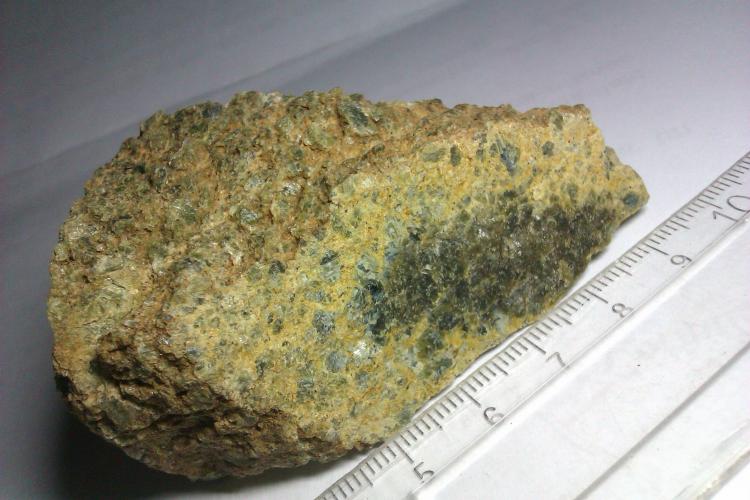
|
| Description: |
Detail of the central area
Sierra Bermeja (Málaga, Spain)
20X
Fresh olivine in the upper side of the photograph. Some olivine crystals in a yellow altered matrix. |
|
| Viewed: |
85260 Time(s) |
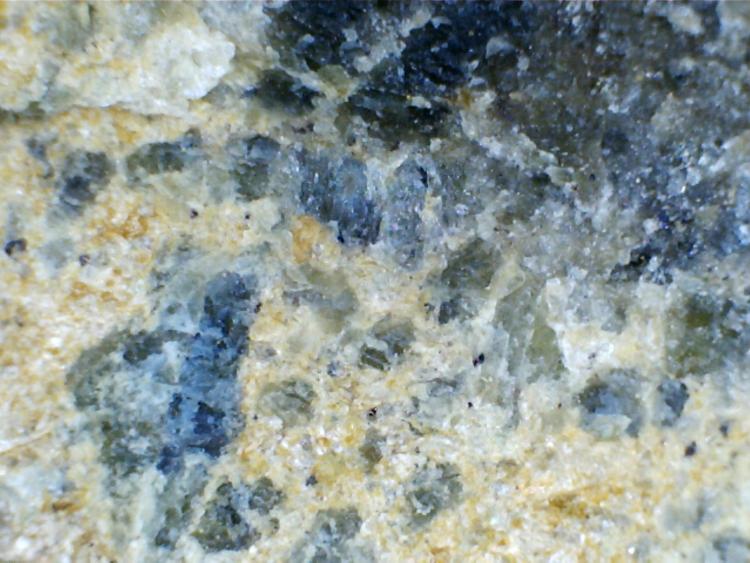
|
| Description: |
Detail near the external surface
Sierra Bermeja (Málaga, Spain)
20X
Alteration colour becomes reddish at the external surface of the rock. Some olivine crystals are though present. |
|
| Viewed: |
85246 Time(s) |
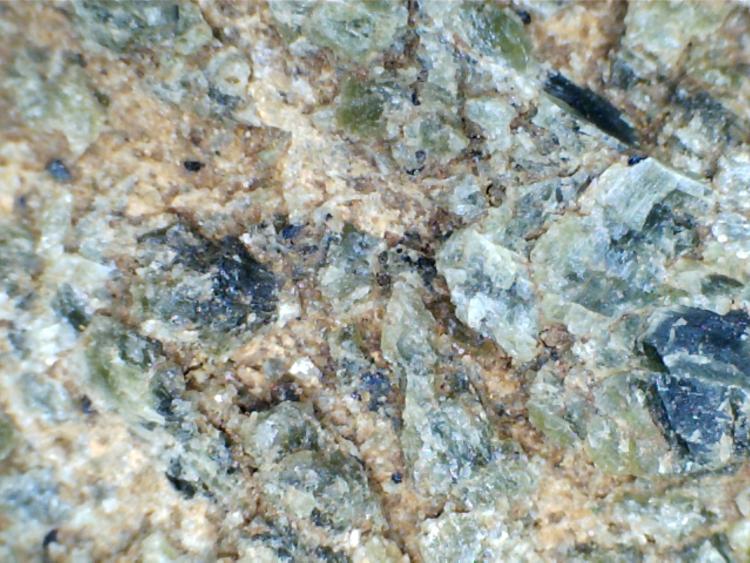
|
_________________
Pablo Rodríguez Cantos
Λίθον˛ον απεδοκίμασαν˛οι οικοδομουντες |
|
| Back to top |
|
 |
Pete Modreski
Site Admin

Joined: 30 Jul 2007
Posts: 709
Location: Denver, Colorado



|
 Posted: Aug 07, 2012 13:14 Post subject: Re: FMF Guide of Rocks - IGNEOUS ROCKS Posted: Aug 07, 2012 13:14 Post subject: Re: FMF Guide of Rocks - IGNEOUS ROCKS |
|
|
Ah, a fine classic locality, the Ronda peridotite! Nice to see the rocks.
I don't know if these Rock Guides are going to generate quite the interest and interchange that the pages of fine mineral specimens do, but... it will be nice to have them!
Pete
|
|
| Back to top |
|
 |
prcantos
Site Admin
Joined: 17 Apr 2012
Posts: 243
Location: Granada (Spain)



|
 Posted: Aug 11, 2012 11:13 Post subject: Re: FMF Guide of Rocks - IGNEOUS ROCKS Posted: Aug 11, 2012 11:13 Post subject: Re: FMF Guide of Rocks - IGNEOUS ROCKS |
|
|
A beautiful syenite with 'labradorescence'.
| Description: |
Larvikite (variety of syenite)
Norway (unknonw locality)
This polished side shows blue iridiscence of labradorite, the main component. Black biotite is also visible. |
|
| Viewed: |
85157 Time(s) |
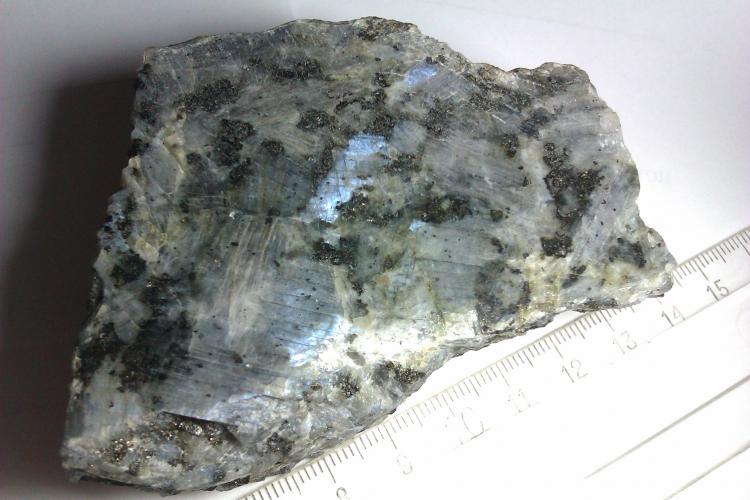
|
_________________
Pablo Rodríguez Cantos
Λίθον˛ον απεδοκίμασαν˛οι οικοδομουντες |
|
| Back to top |
|
 |
prcantos
Site Admin
Joined: 17 Apr 2012
Posts: 243
Location: Granada (Spain)



|
 Posted: Sep 19, 2012 11:15 Post subject: Re: FMF Guide of Rocks - IGNEOUS ROCKS Posted: Sep 19, 2012 11:15 Post subject: Re: FMF Guide of Rocks - IGNEOUS ROCKS |
|
|
Andesite is an intermediate volcanic rock lying in 9 & 10 QAPF fields (if modal classification is available). Differences between basalt and andesite (they share these fields) are:
- Andesite is more silika-rich than basalt.
- Andesite has higher colour index than basalt.
Andesites are Island Arc-type and orogenic subduction zones rocks.
| Description: |
Hornblende Porphyritic Andesite
Carboneras (Almería, Spain) |
|
| Viewed: |
84975 Time(s) |
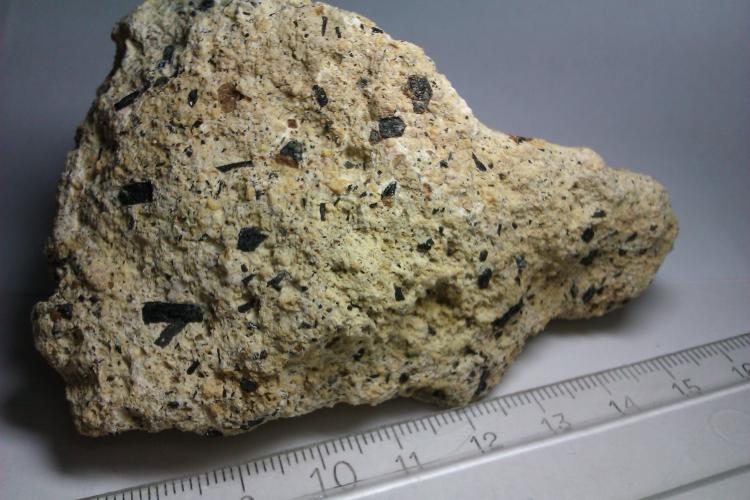
|
| Description: |
Hornblende Porphyritic Andesite
Carboneras (Almería, Spain) |
|
| Viewed: |
84816 Time(s) |
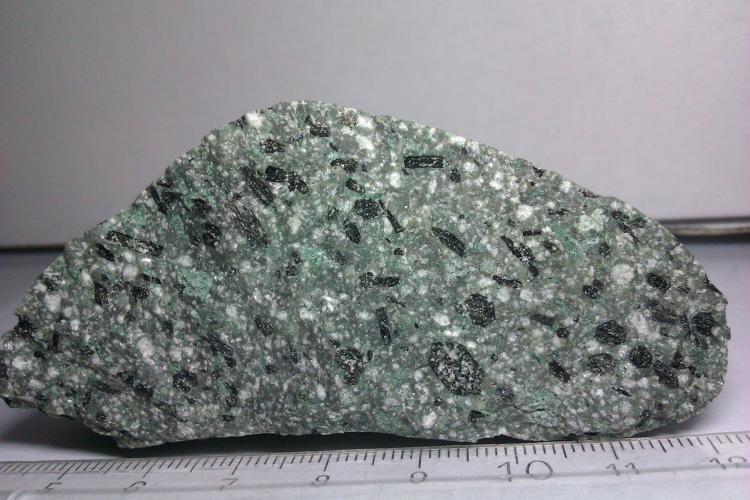
|
| Description: |
Hornblende crystal in previous andesite
Carboneras (Almería, Spain)
20X
Typical pseudohexagonal section of amphiboles. |
|
| Viewed: |
84689 Time(s) |
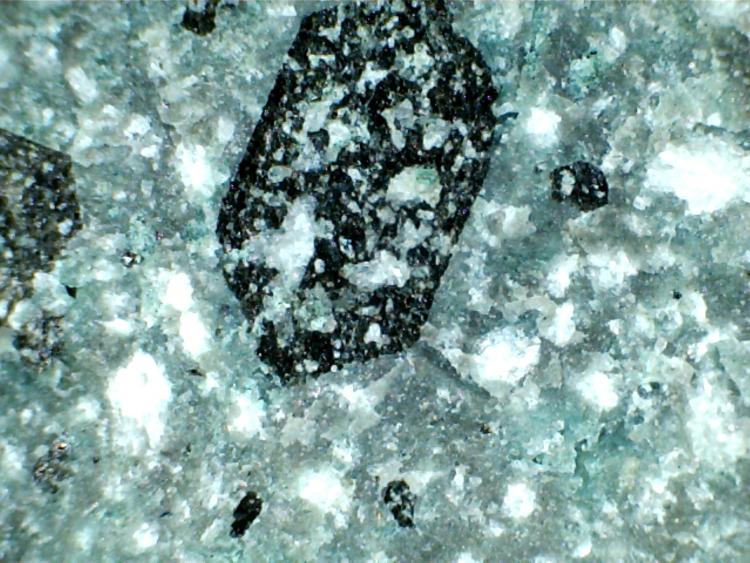
|
_________________
Pablo Rodríguez Cantos
Λίθον˛ον απεδοκίμασαν˛οι οικοδομουντες |
|
| Back to top |
|
 |
mihailovici79

Joined: 07 Sep 2011
Posts: 111
Location: Timisoara



|
 Posted: Sep 19, 2012 12:05 Post subject: Re: FMF Guide of Rocks - IGNEOUS ROCKS Posted: Sep 19, 2012 12:05 Post subject: Re: FMF Guide of Rocks - IGNEOUS ROCKS |
|
|
Thank you for your posts. Useful explanations.
Best regards
Mihail
|
|
| Back to top |
|
 |
prcantos
Site Admin
Joined: 17 Apr 2012
Posts: 243
Location: Granada (Spain)



|
 Posted: Sep 21, 2012 07:51 Post subject: Re: FMF Guide of Rocks - IGNEOUS ROCKS Posted: Sep 21, 2012 07:51 Post subject: Re: FMF Guide of Rocks - IGNEOUS ROCKS |
|
|
Feldspar-rich pegmatite from central Iberian massif.
| Description: |
Feldspar pegmatite
San Martín de Montalbán (Toledo, Spain)
The rock consists of a net of big crystals of feldspar (mainly K-feldspar). |
|
| Viewed: |
84692 Time(s) |
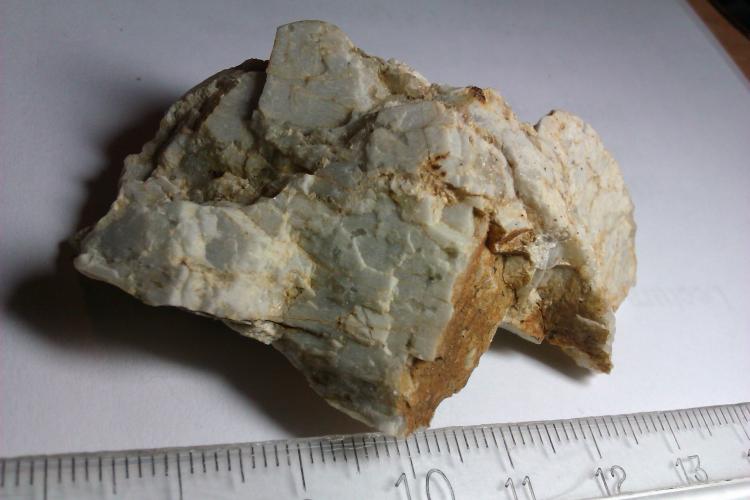
|
| Description: |
Feldspar pegmatite (detail)
San Martín de Montalbán (Toledo, Spain)
Quartz inclusions inside the feldspar, near graphic texture. |
|
| Viewed: |
84657 Time(s) |
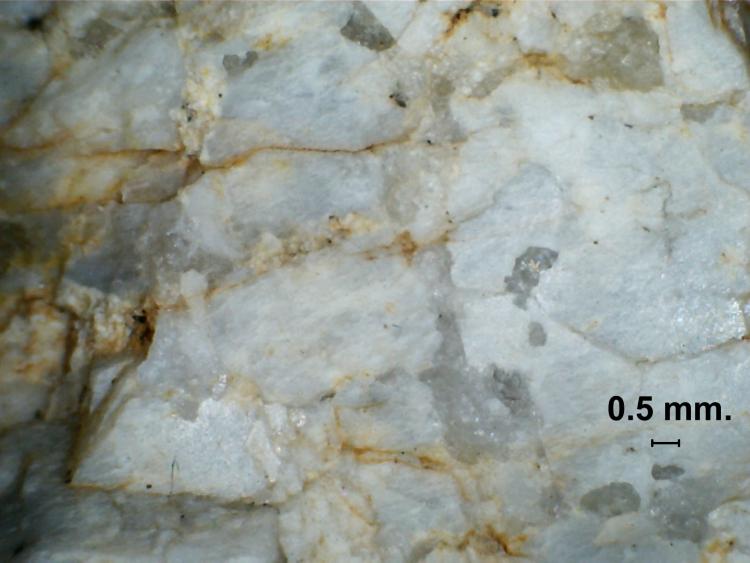
|
_________________
Pablo Rodríguez Cantos
Λίθον˛ον απεδοκίμασαν˛οι οικοδομουντες |
|
| Back to top |
|
 |
prcantos
Site Admin
Joined: 17 Apr 2012
Posts: 243
Location: Granada (Spain)



|
 Posted: Jan 05, 2013 15:53 Post subject: Re: FMF Guide of Rocks - IGNEOUS ROCKS Posted: Jan 05, 2013 15:53 Post subject: Re: FMF Guide of Rocks - IGNEOUS ROCKS |
|
|
Volcanic rock dacite bearing almandine xenoliths.
| Description: |
Dacite with almandine xenoliths
El Hoyazo, Níjar, Almería, Andalusia, Spain
8x6 cm.
Calcoalcaline-potassic magma ascended trhough Carboneras fault and pulle out garnets from gneisses and schists of basement, which were finally added to the solid rock as xenoliths. |
|
| Viewed: |
83567 Time(s) |
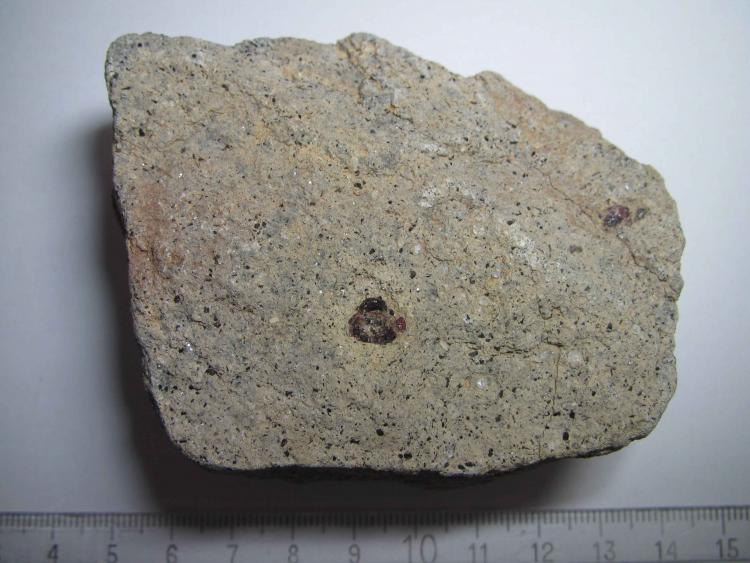
|
| Description: |
Dacite with almandine xenoliths (detailed view)
El Hoyazo, Níjar, Almería, Andalusia, Spain
30X
Minerals forming the rock: reddish almandine (altered), white quartz, cream-coloured feldspars, black biotite, blue cordierite. |
|
| Viewed: |
83543 Time(s) |
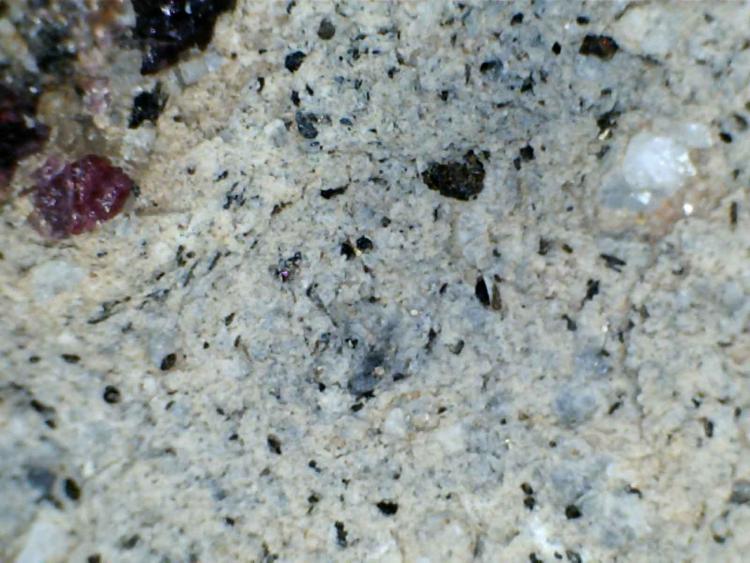
|
_________________
Pablo Rodríguez Cantos
Λίθον˛ον απεδοκίμασαν˛οι οικοδομουντες |
|
| Back to top |
|
 |
prcantos
Site Admin
Joined: 17 Apr 2012
Posts: 243
Location: Granada (Spain)



|
 Posted: Jan 18, 2013 07:15 Post subject: Re: FMF Guide of Rocks - IGNEOUS ROCKS Posted: Jan 18, 2013 07:15 Post subject: Re: FMF Guide of Rocks - IGNEOUS ROCKS |
|
|
Troctolite is a plutonic rock belonging to gabbro group, composed mainly by plagioclase feldspar (anorthite) and olivine, with small amounts of piroxene and no-quartz.
| Description: |
Troctolite
Kawishivi, Duluth Complex, Minnesota, USA
16x6 cm.
Tabular plagioclase crystals can bee seen shining in the dark-coloured matrix. |
|
| Viewed: |
83398 Time(s) |
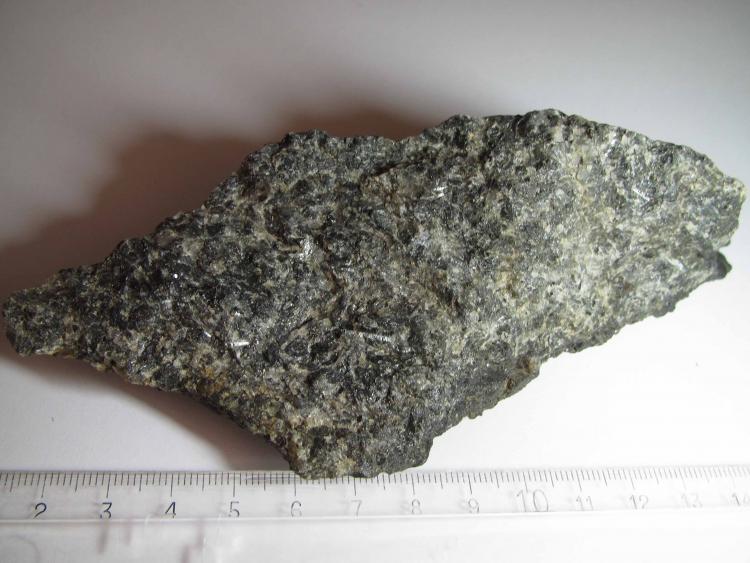
|
| Description: |
Troctolite (detailed view)
Kawishivi, Duluth Complex, Minnesota, USA
8 mm. long the tabular plagioclase crystal
Minerals in this gabbroic plutonite are: olivine (greenish, o better brownish-coloured), plagioclase feldspars (white, often forming tabular crystals), piroxene (green or dark-coloured). |
|
| Viewed: |
83334 Time(s) |
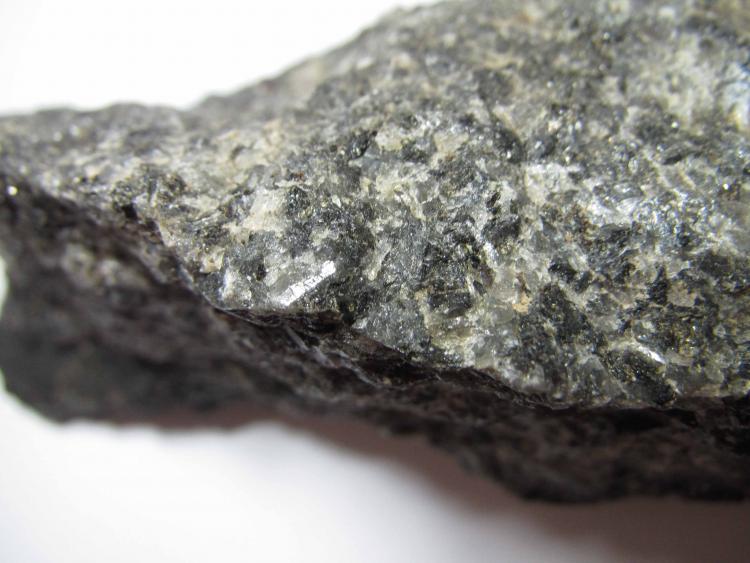
|
_________________
Pablo Rodríguez Cantos
Λίθον˛ον απεδοκίμασαν˛οι οικοδομουντες |
|
| Back to top |
|
 |
prcantos
Site Admin
Joined: 17 Apr 2012
Posts: 243
Location: Granada (Spain)



|
 Posted: Jan 21, 2013 12:44 Post subject: Re: FMF Guide of Rocks - IGNEOUS ROCKS Posted: Jan 21, 2013 12:44 Post subject: Re: FMF Guide of Rocks - IGNEOUS ROCKS |
|
|
A kind spanish FMF-Forum member has given permission to show here his photographs of rocks. This is really a great contribution.
I show two ingimbrites, pyroclastic rocks from Islas Canarias. Ignimbrites are a type of welded-tuff consisting of crystal and rocks fragments in a matrix of glass shards called "flames". Sometimes these components give the rock a fluent texture similar to schistosity; or maybe compactation is so developed that flames-texture is lost.
| Description: |
Ignimbrite
Caldera de Bandama, Gran Canaria, Islas Canarias, Spain
9 cm. width
With the kind permission of a spanish-FMF Forum member.
Look at the fluent texture according to glass fragments and bubbles. |
|
| Viewed: |
83366 Time(s) |
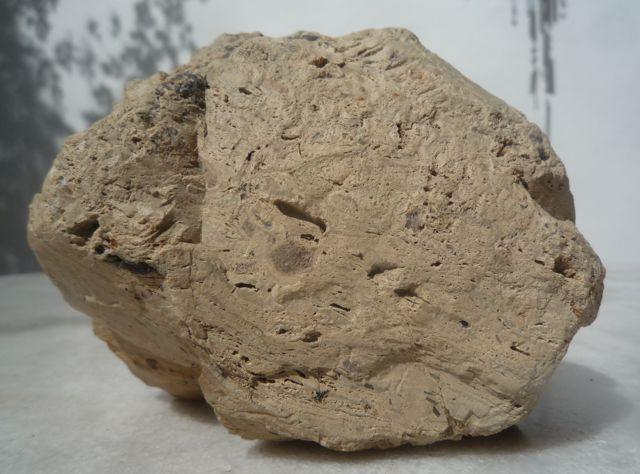
|
| Description: |
Ignimbrite
Las Palmas, Gran Canaria, Islas Canarias, Spain
11 cm. width
With the kind permission of a spanish-FMF Forum member.
1 mm. thickness foliation similar to schistosity. |
|
| Viewed: |
83342 Time(s) |
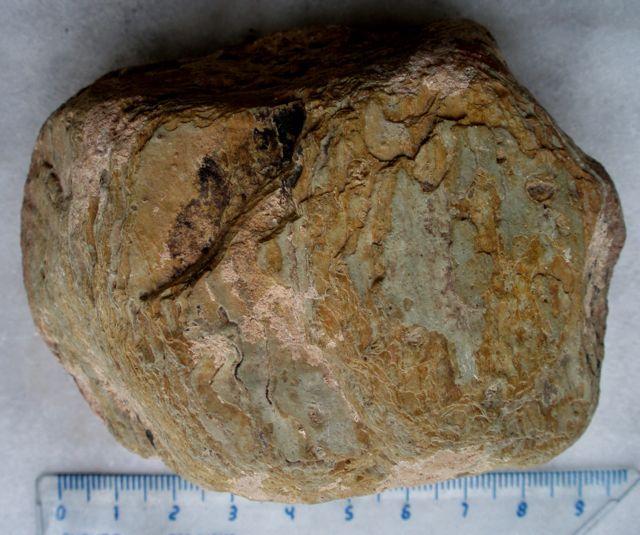
|
_________________
Pablo Rodríguez Cantos
Λίθον˛ον απεδοκίμασαν˛οι οικοδομουντες |
|
| Back to top |
|
 |
prcantos
Site Admin
Joined: 17 Apr 2012
Posts: 243
Location: Granada (Spain)



|
 Posted: Feb 24, 2013 16:50 Post subject: Re: FMF Guide of Rocks - IGNEOUS ROCKS: spilites and spilitic rocks Posted: Feb 24, 2013 16:50 Post subject: Re: FMF Guide of Rocks - IGNEOUS ROCKS: spilites and spilitic rocks |
|
|
I am using the title of the 1974 Amstutz collection of papers to show here some lightly altered greenish igneous rocks. I'm afraid there is no agreement on nomenclature and classifications; anyway I give here the definition by IUGS-SSIR & SSMR.
SPILITE: A term originally used for altered phenocryst-poor or aphyric basaltic rocks but later used for altered (often albitized) basaltic lavas. Now it is used for altered basic to intermediate, volcanic or subvolcanic rock in wich the feldspar is partially or completely composed by chlorite, calcite, quartz, epidote, prehnite and low-temperature hydrous crystallization products. Preservation of eruptive (volcanic and subvolcanic) features is an important characteristic of spilites. The term may be replaced by metabasalt or meta-andesite, as appropriate, regardless of the origin of the rock.
It has been widely discussed if spilites are rocks formed from a primary spilitic magma, or rocks originated by autohydrothermal or autometamorphic processes, or they are secondary metamorphic rocks.
References
* G. C. Amstutz (ed.), Spilites and Spilitic Rocks, Berlin 1974.
* R. W. Le Maitre, Igneous Rocks, A Classification and Glossary of Terms, Cambridge (UK) 2004.
* D. Fettes & J. Desmons (ed.), Metamorphic Rocks, A Classification and Glossary of Terms, Cambridge (UK) 2007.
| Description: |
Miarolitic granite
Wimmer's Quarry, Nine Mile Pluton, Wausau Complex, Marathon County, Wisconsin, USA
7 x 6 cm.
Miarolitic (i. e. containing many irregular drusy cavities) granite often called 'rotten granite' because of secondary green minerals. |
|
| Viewed: |
83007 Time(s) |
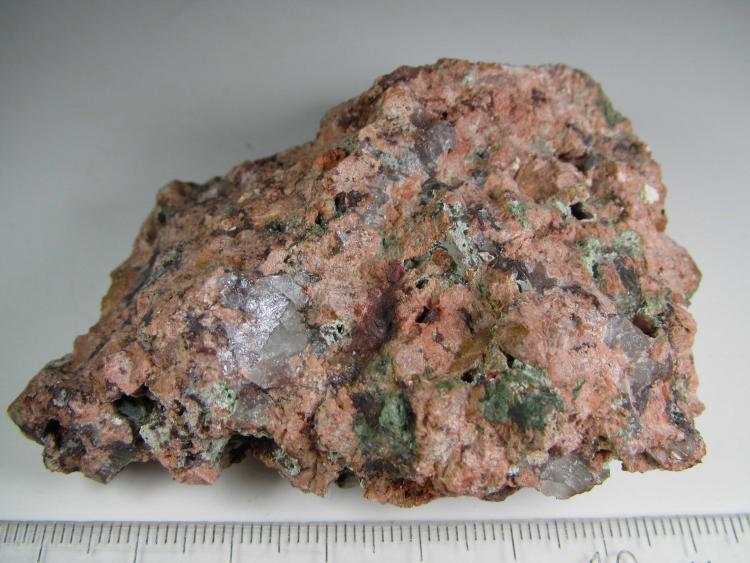
|
| Description: |
Miarolitic granite (detail)
Wimmer's Quarry, Nine Mile Pluton, Wausau Complex, Marathon County, Wisconsin, USA
FOV 4 cm. |
|
| Viewed: |
82951 Time(s) |
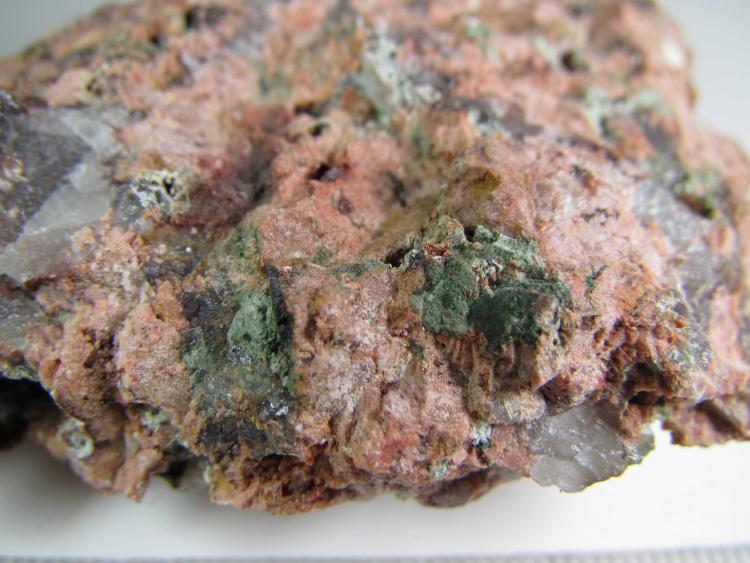
|
| Description: |
Meta-trachyte
La Sierrecica, Cuevas del Almanzora-Los Lobos, Almería, Andalucía, Spain
10 x 9 cm.
Hydrothermal alteration of this sanidine-trachyte has produced these vesicular-like greenish formations. |
|
| Viewed: |
82878 Time(s) |
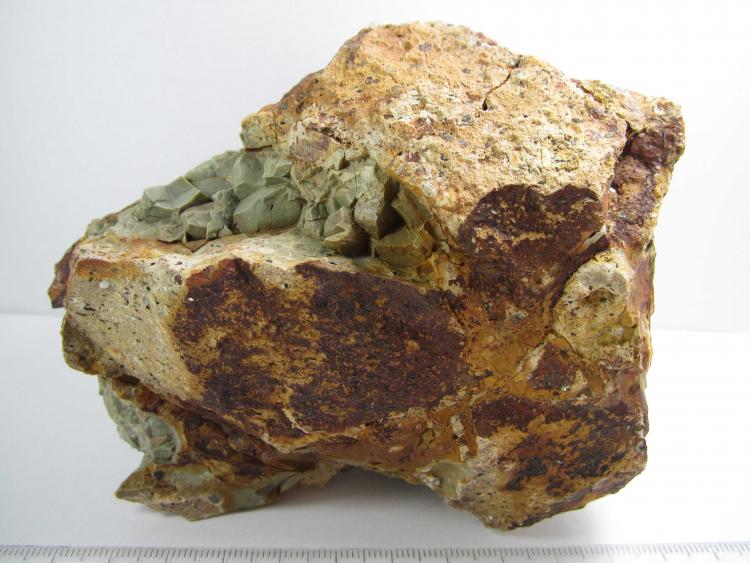
|
| Description: |
Meta-trachyte (detail)
La Sierrecica, Cuevas del Almanzora-Los Lobos, Almería, Andalucía, Spain
FOV 6 cm.
Black or shining flakes are biotite; brownish iron oxides are also visible. |
|
| Viewed: |
82947 Time(s) |
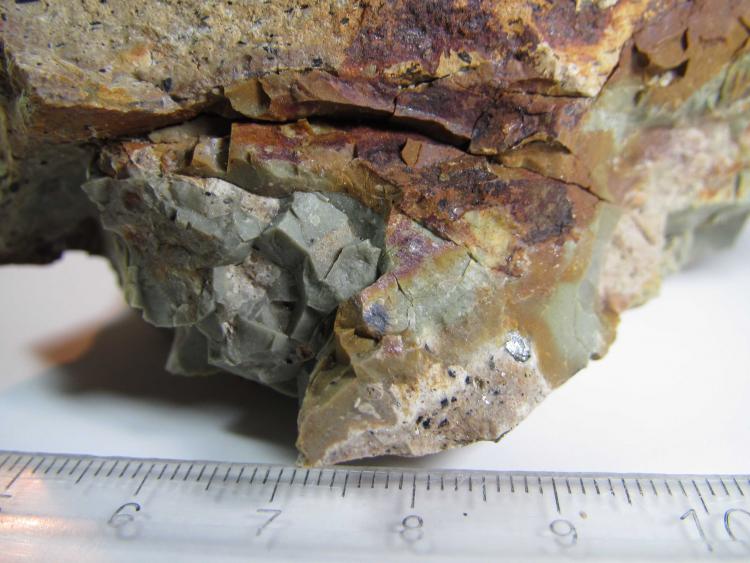
|
| Description: |
Epidote meta-basalt
Alhambra formation, Dílar, Granada, Andalucía, Spain
14 x 9 cm.
I collected this rock in the western glacis of Sierra Nevada. A green epidote layer covers the fresh porous basaltic rock. Look at the wrinkles similar to those on the surface of some volcanic bombs. |
|
| Viewed: |
82932 Time(s) |
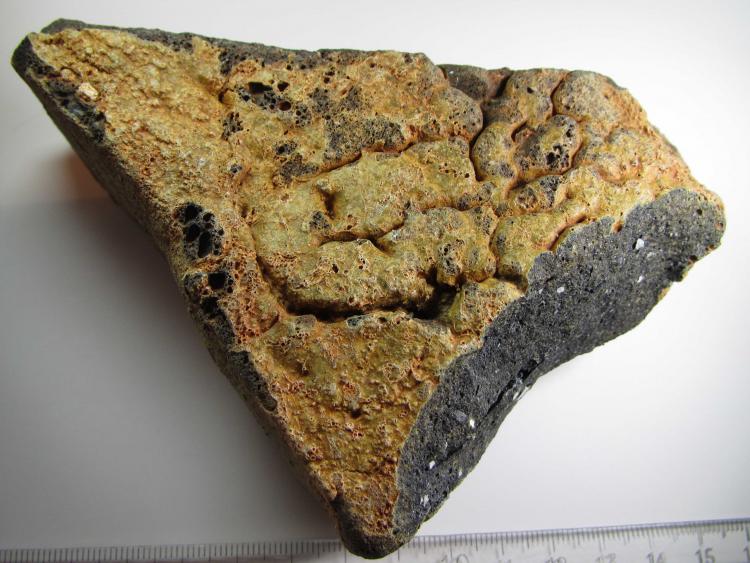
|
| Description: |
Epidote meta-basalt (detail)
Alhambra formation, Dílar, Granada, Andalucía, Spain
FOV 6 cm.
White calcite fills some of the cavities. New brown alteration focal points can be noticed. |
|
| Viewed: |
82847 Time(s) |
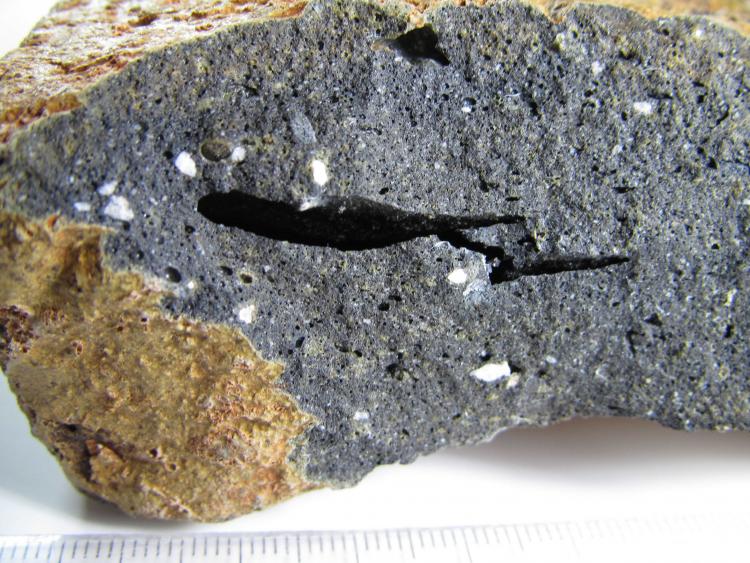
|
| Description: |
Trap-rock / amygdaloid basalt
Germany
7 x 5 cm.
Secondary minerals fill cavities. |
|
| Viewed: |
83486 Time(s) |
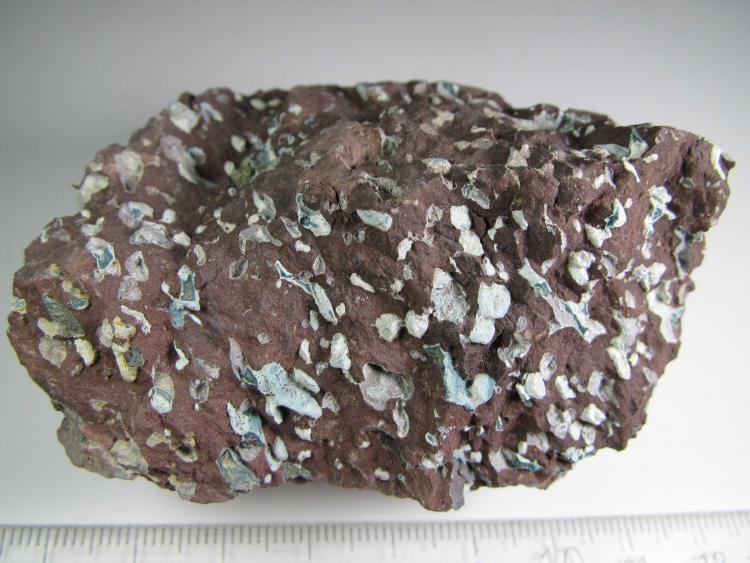
|
| Description: |
Trap-rock / amygdaloid basalt (detail)
Germany
FOV 3 cm. |
|
| Viewed: |
82948 Time(s) |
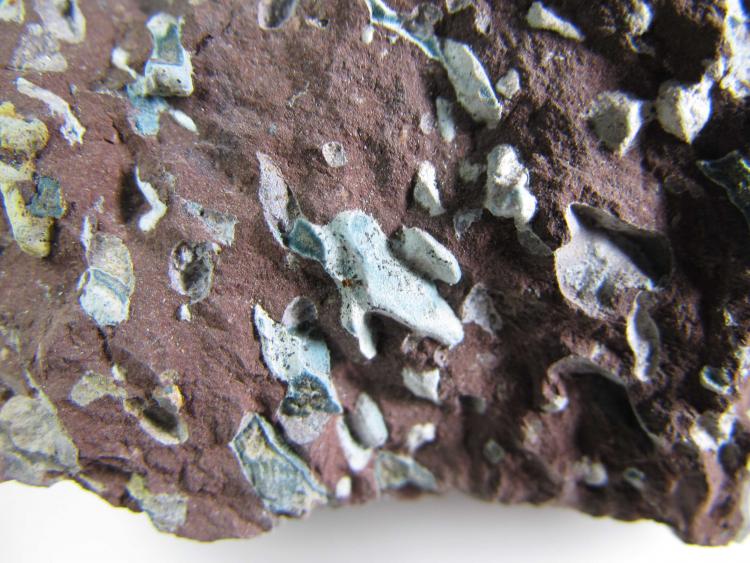
|
| Description: |
Pillow-lava metabasite
Alamedilla, Granada, Andalucía, Spain
6 x 7 cm.
In Alamedilla basaltic-basanitic pillow-lavas we can find these greenish vesicles similar to peas. Sometimes they are empty and holey. Calcite and iron oxides also appear in the specimen. |
|
| Viewed: |
82925 Time(s) |
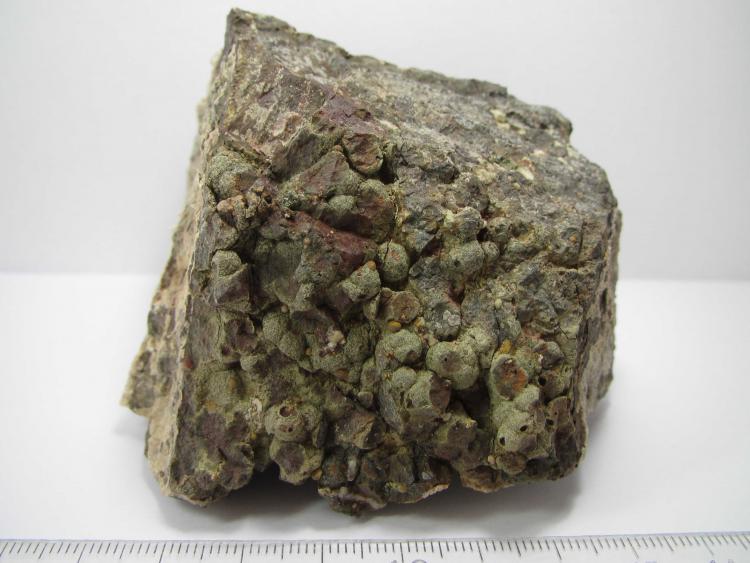
|
| Description: |
Pillow-lava metabasite (detail)
Alamedilla, Granada, Andalucía, Spain |
|
| Viewed: |
82960 Time(s) |
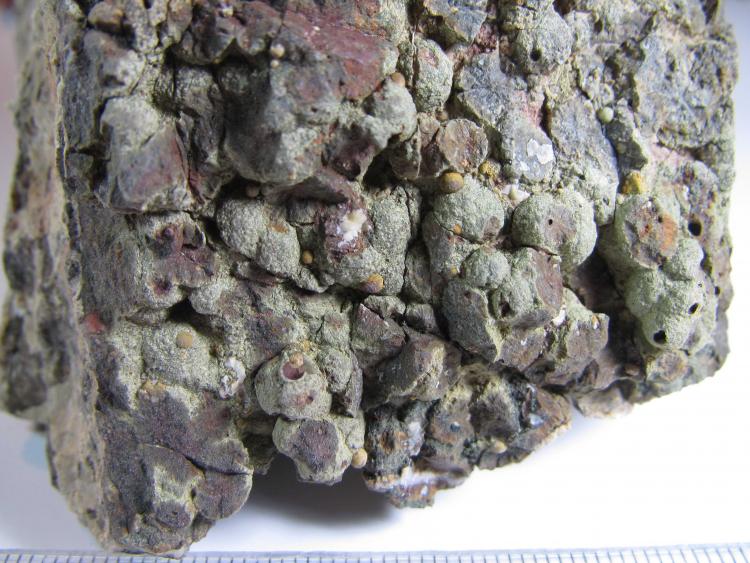
|
_________________
Pablo Rodríguez Cantos
Λίθον˛ον απεδοκίμασαν˛οι οικοδομουντες |
|
| Back to top |
|
 |
prcantos
Site Admin
Joined: 17 Apr 2012
Posts: 243
Location: Granada (Spain)



|
 Posted: Feb 28, 2013 12:00 Post subject: Re: FMF Guide of Rocks - IGNEOUS ROCKS: alkaline rocks Posted: Feb 28, 2013 12:00 Post subject: Re: FMF Guide of Rocks - IGNEOUS ROCKS: alkaline rocks |
|
|
Alkaline igneous rocks are those which contain either
1) modal foids and/or alkali amphiboles or pyroxenes
or
2) normative foids or acmite (aegirine).
They come from K and Na-rich silica-unsaturated magmas.
Definitions from R. W. Le Maitre, Igneous Rocks, A Classification and Glossary of Terms, Cambridge (UK) 2004.
| Description: |
Nepheline syenite
Mt. St. Hilaire, Québec, Canada
2 x 1.3 cm. |
|
| Viewed: |
82630 Time(s) |
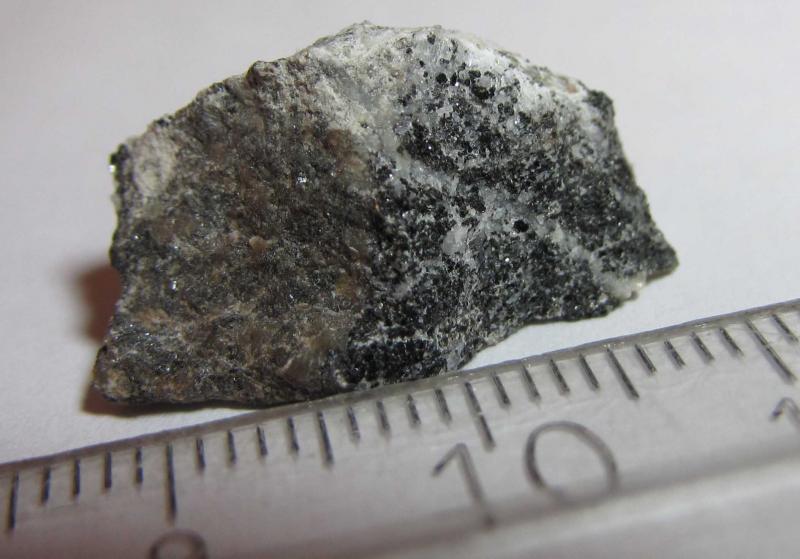
|
| Description: |
Nepheline syenite
Zunker's pit, Stettin pluton, Marathon County, Wisconsin, USA
10 x 7 cm. |
|
| Viewed: |
82720 Time(s) |
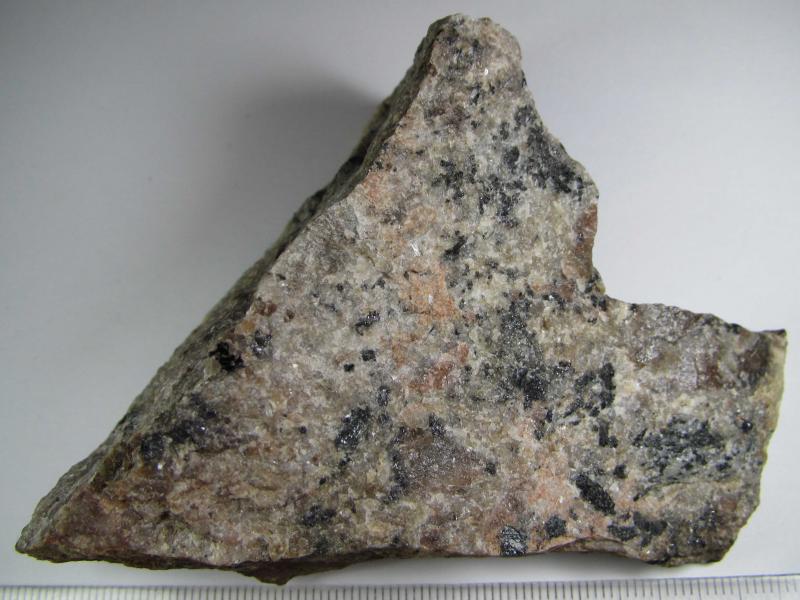
|
| Description: |
Pulaskite
Grenville, Québec, Canada
1.8 x 1 cm.
A variety of nepheline-bearing alkali feldspar syenite containing akali feldspar and varying amounts of sodic pyroxenes and amphiboles, fayalite, biotite and minor amounts of nepheline. |
|
| Viewed: |
82620 Time(s) |
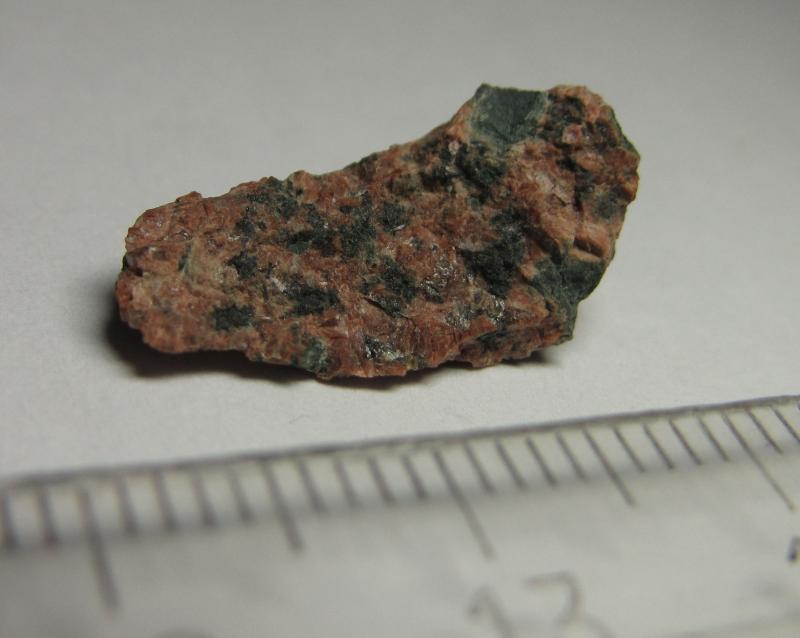
|
| Description: |
Lujavrite
Greenland
2 x 1 cm.
Agpaitic melanosyenite rich in eudialyte, arfvedsonite and aegirine with perthitic alkali feldspar or separate microcline and albite. |
|
| Viewed: |
82553 Time(s) |
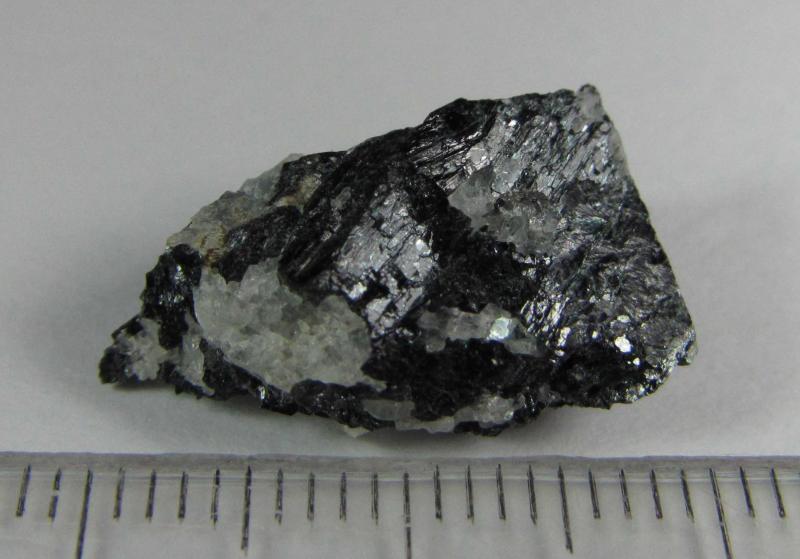
|
| Description: |
Naujaite
Illimaussaq Complex, Kangerdlussaq Fjord, Julianebab District, Southern Greenland
7 x 6.5 cm.
Agpaitic variety of nepheline sodalite syenite characterized by a poikilitic texture with smal crystals of sodalite (gray grains) enclosed in large grains of alkali feldspar, arfvedsonite, aegirine and eudialyte (pink grains). |
|
| Viewed: |
82564 Time(s) |
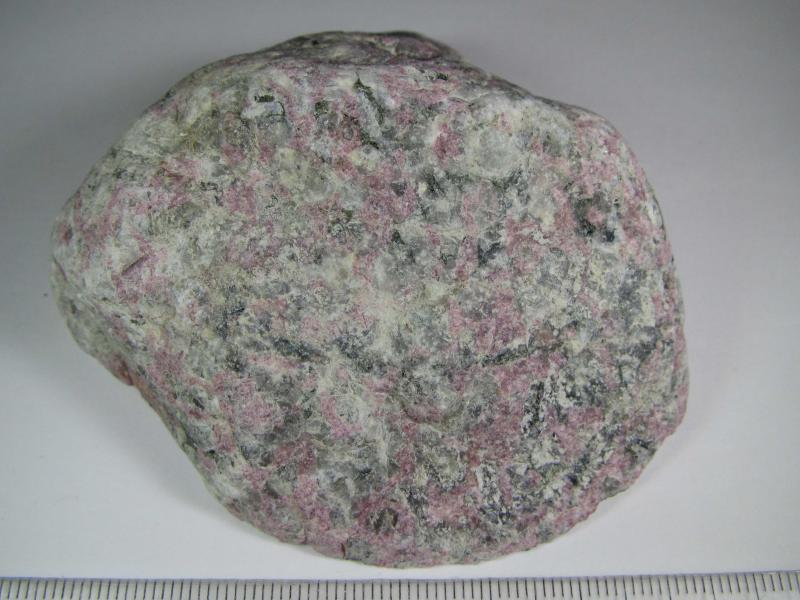
|
| Description: |
Kakortokite
Illimaussaq Complex, Kangerdlussaq Fjord, Julianebab District, Southern Greenland
8 x 4.5 cm.
Agpaitic nepheline syenite displaying pronounced cumulate textures and igneous layering with a repetition of layers enriched in alkali feldspar, eudialyte (pink) and arfvedsonite (black). Nepheline is white. |
|
| Viewed: |
82566 Time(s) |
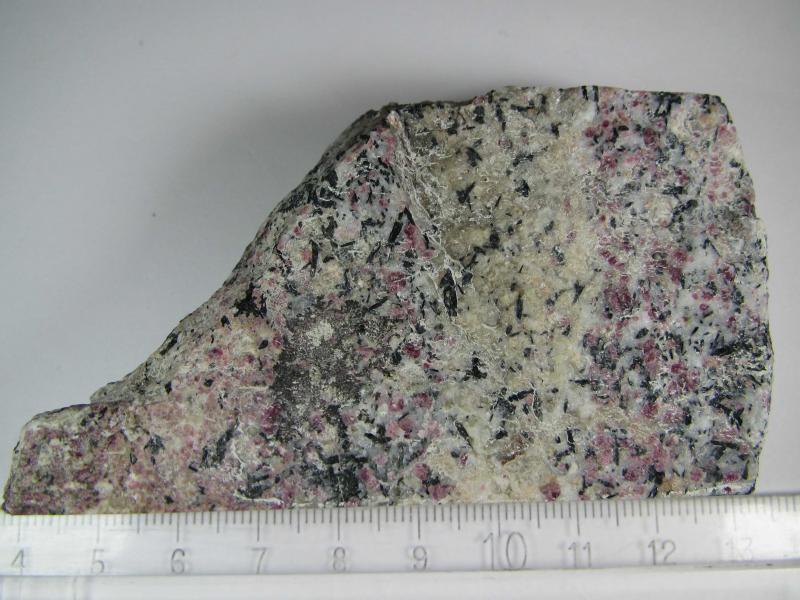
|
| Description: |
Phonolite
North Berwick Law, Scotland, UK
7 x 4 cm. |
|
| Viewed: |
82570 Time(s) |
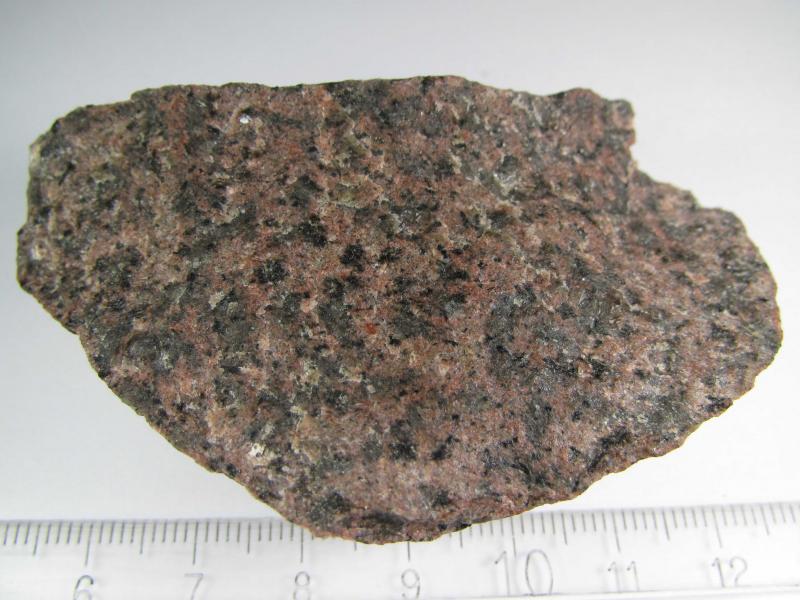
|
| Description: |
Phonolite
Ansite, Gran Canaria, Islas Canarias, Spain
6 x 4 cm. |
|
| Viewed: |
82611 Time(s) |
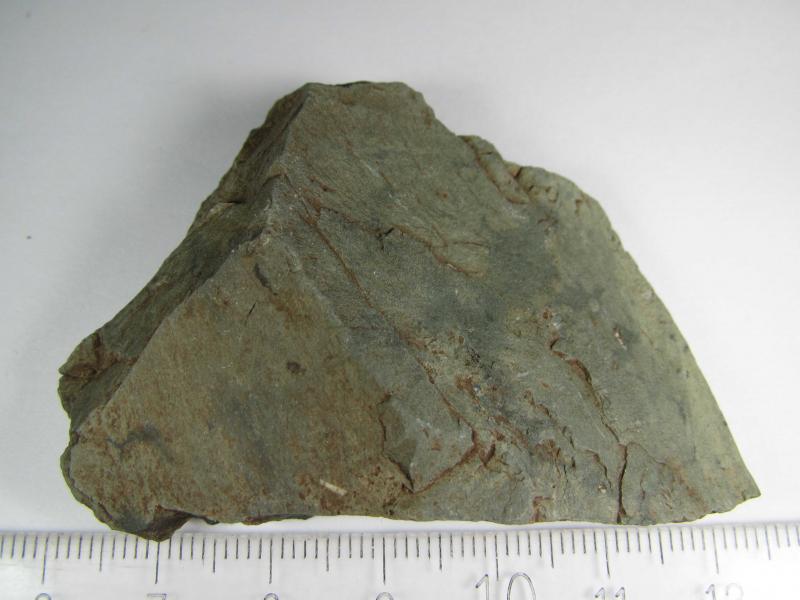
|
| Description: |
Tinguaite
Särna (Sweden), but found in Denmark because of glacial transportation
3.5 x 3 cm.
Variety of phonolite consisting of alkali fedspar, nepheline with or without other foids, aegirine (black) and sometimes biotite and characterized by "tinguaitic texture" in which needles of aegirine occur insterstically in a mozaic of alkali feldspar and foids. |
|
| Viewed: |
82628 Time(s) |
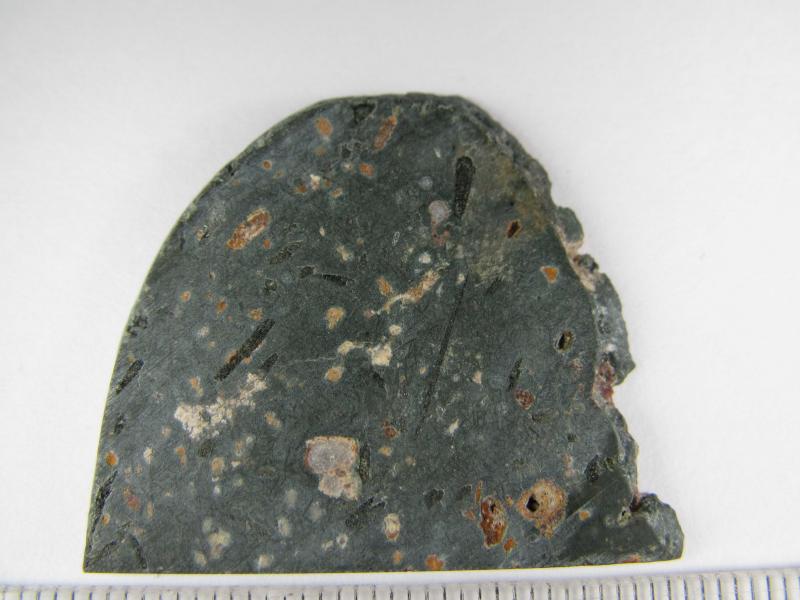
|
| Description: |
Sodalite foidolite
Namibia
12.5 x 8 cm. |
|
| Viewed: |
82783 Time(s) |
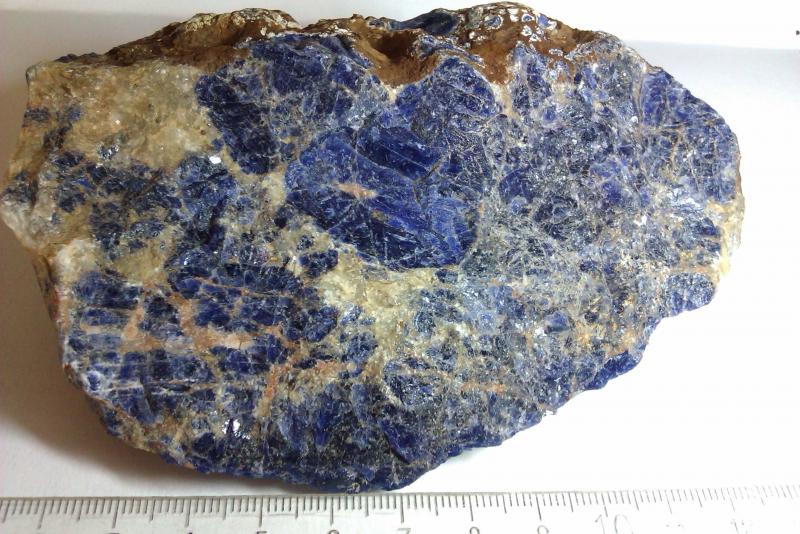
|
| Description: |
Urtite
Oka, Deux-Montagnes County, Québec, Canada
2.5 x 3 cm.
Leucocratic variety of foidolite consisting of over 70% nepheline with some aegirine-augite but no feldspar. |
|
| Viewed: |
82539 Time(s) |
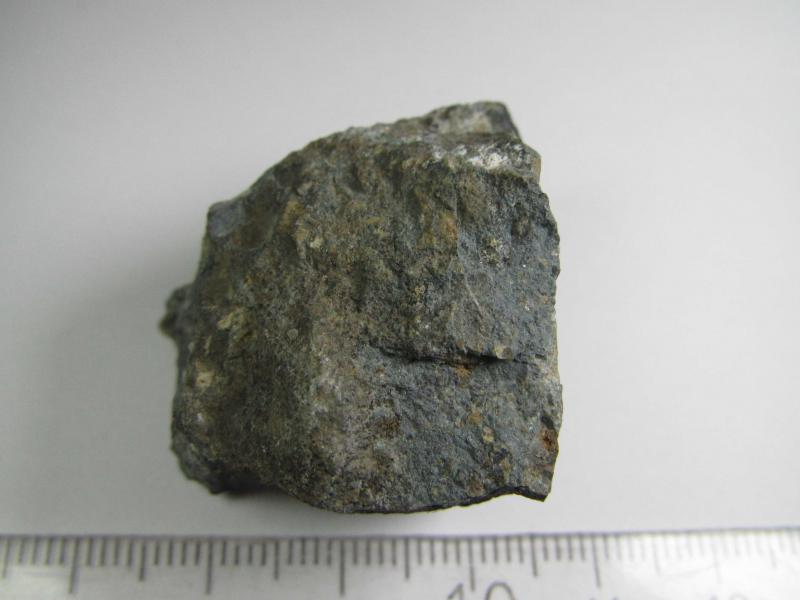
|
_________________
Pablo Rodríguez Cantos
Λίθον˛ον απεδοκίμασαν˛οι οικοδομουντες |
|
| Back to top |
|
 |
Roger Warin

Joined: 23 Jan 2013
Posts: 1176



|
 Posted: Oct 05, 2013 16:02 Post subject: Re: FMF Guide of Rocks - IGNEOUS ROCKS Posted: Oct 05, 2013 16:02 Post subject: Re: FMF Guide of Rocks - IGNEOUS ROCKS |
|
|
Hi rock Lovers.
This crystal is a calcium-rich pyroxene, in fact augite (fassaite variety). It is not very big, but it is well formed.
Its characteristic is to have crystallized in space on an asteroid.
Indeed, the meteorite found in Argentina in 1979 at D'Orbigny is an angrite. It is a type of basaltic igneous rock, but D'Orbigny contains vacuoles that allow the crystallization of pyroxene.
The mineralogy of celestial rocks is similar to that of terrestrial rocks, but sometimes with differences. So, in meteorites there is no amphibole (which requires the presence of water).
Roger
| Description: |
Augite crystal in basalt
Space ! |
|
| Viewed: |
79198 Time(s) |
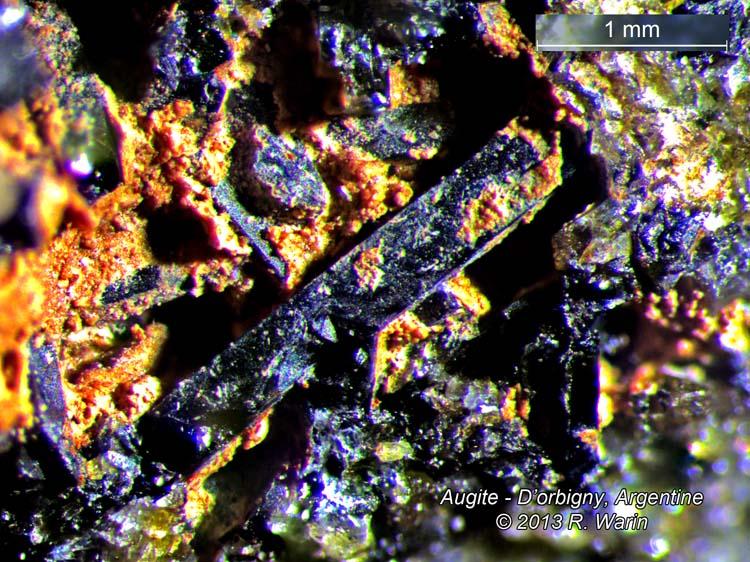
|
|
|
| Back to top |
|
 |
prcantos
Site Admin
Joined: 17 Apr 2012
Posts: 243
Location: Granada (Spain)



|
 Posted: Feb 18, 2014 16:36 Post subject: Re: FMF Guide of Rocks - IGNEOUS ROCKS Posted: Feb 18, 2014 16:36 Post subject: Re: FMF Guide of Rocks - IGNEOUS ROCKS |
|
|
Limburgite is the non-systematic name for 'a basic volcanic rock containing phenocrysts of pyroxene, olivine and opaque in a glassy groundmass containing the same minerals. No feldspars are present' (cf. R. W. Le Maitre (ed.), Igneous Rocks, A Classification and Glossary of Terms, Cambridge 2004, p. 104). The systematic name may be hyalo-nepheline basanite. See some detailed pictures of the minerals in this rock here.
| Description: |
Limburgite (hyalo nepheline-basanite)
Limberg Quarries, Sasbach, Kaiserstuhl, Baden-Württemberg, Germany
4'5 x 3 cm.
This rock contains many cavities bearing zeolites (phillipsite) ± calcite. Augite is black, altered olivine is brownish, and the glass is dark brown coloured. |
|
| Viewed: |
76991 Time(s) |
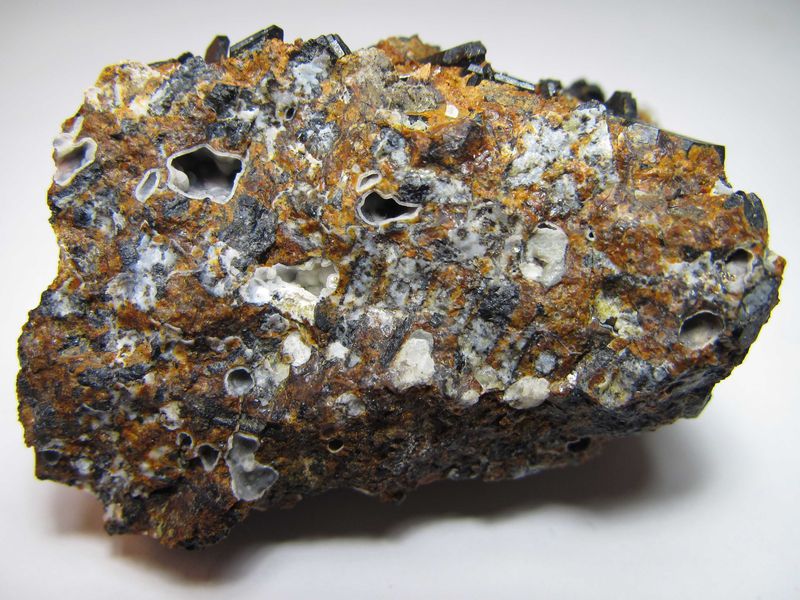
|
| Description: |
Limburgite (hyalo nepheline-basanite)
Limberg Quarries, Sasbach, Kaiserstuhl, Baden-Württemberg, Germany
4'5 x 4'5
Another side of the same specimen. |
|
| Viewed: |
77036 Time(s) |
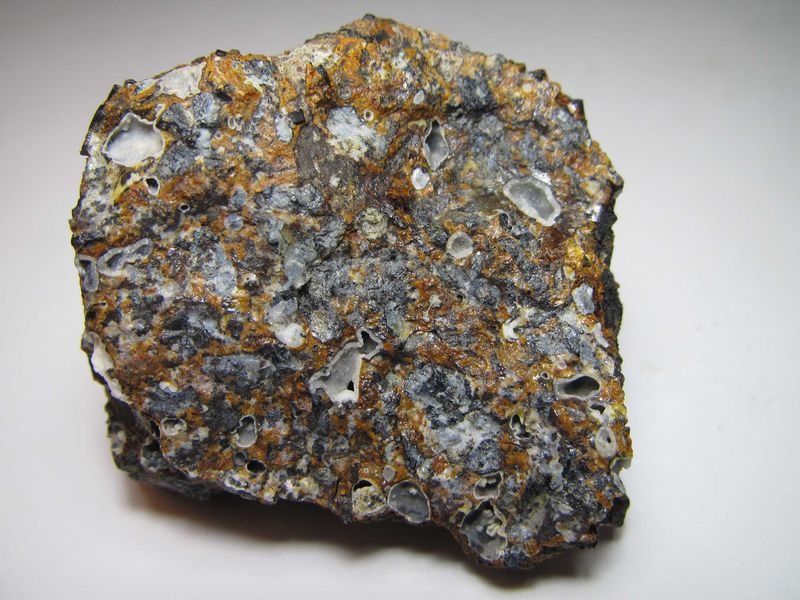
|
| Description: |
Limburgite (hyalo nepheline-basanite)
Limberg Quarries, Sasbach, Kaiserstuhl, Baden-Württemberg, Germany
4'5 x 3 cm.
This side shows many idiomorphic augite crystals. |
|
| Viewed: |
76967 Time(s) |
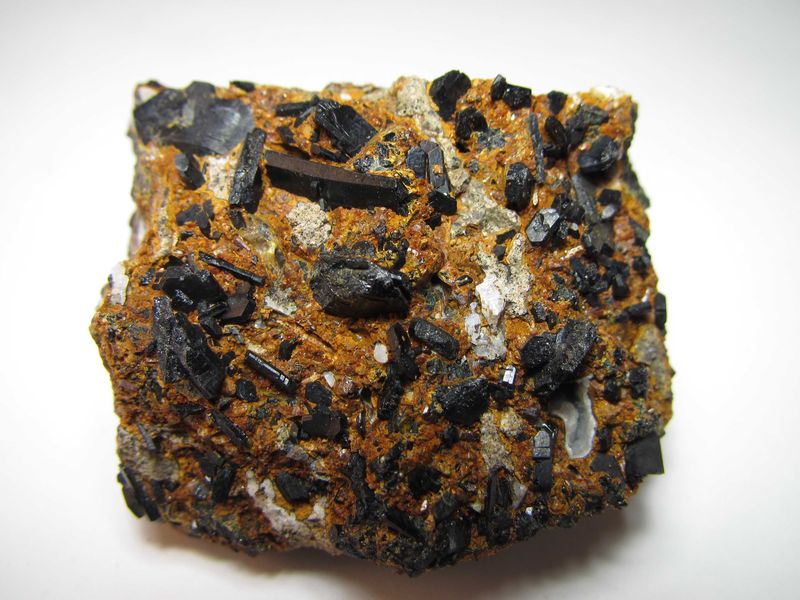
|
_________________
Pablo Rodríguez Cantos
Λίθον˛ον απεδοκίμασαν˛οι οικοδομουντες |
|
| Back to top |
|
 |
|


